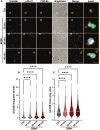Synaptic accumulation of GluN2B-containing NMDA receptors mediates the effects of BDNF-TrkB signalling on synaptic plasticity and in hyperexcitability during status epilepticus
- PMID: 40890771
- PMCID: PMC12400769
- DOI: 10.1186/s12929-025-01164-4
Synaptic accumulation of GluN2B-containing NMDA receptors mediates the effects of BDNF-TrkB signalling on synaptic plasticity and in hyperexcitability during status epilepticus
Abstract
Background: Brain-derived neurotrophic factor (BDNF) is a key mediator of synaptic plasticity and memory formation in the hippocampus. However, the BDNF-induced alterations in the glutamate receptors coupled to the plasticity of glutamatergic synapses in the hippocampus have not been elucidated. In this work we investigated the putative role of GluN2B-containing NMDA receptors in the plasticity of glutamatergic synapses induced by BDNF.
Methods: The effects of BDNF on the surface expression of GluN2B-containing NMDA receptors was investigated in cultured hippocampal neurons and in hippocampal synaptoneurosomes by immunocytochemistry under non-permeabilizing conditions, using an antibody that binds to an extracellular epitope. Long term potentiation of hippocampal CA1 synapses was induced by using θ-burst stimulation. Epileptic seizures were induced using the Li+-pilocarpine model of temporal lobe epilepsy. Pyk2 phosphorylation was assessed by western blot with a phosphospecific antibody.
Results: Stimulation of hippocampal synaptoneurosomes with BDNF led to a significant time-dependent increase in the synaptic surface expression of GluN2B-containing NMDA receptors as determined by immunocytochemistry with colocalization with pre- (vesicular glutamate transporter) and post-synaptic markers (PSD-95). Similarly, BDNF induced the synaptic accumulation of GluN2B-containing NMDA receptors at the synapse in cultured hippocampal neurons, by a mechanism sensitive to the PKC inhibitor GӦ6983. The effects of PKC may be mediated by phosphorylation of Pyk2, as suggested by western blot experiments analyzing the phosphorylation of the kinase on Tyrosine 402. GluN2B-containing NMDA receptors mediated the effects of BDNF in the facilitation of the early phase of long-term potentiation (LTP) of hippocampal CA1 synapses induced by θ-burst stimulation, since the effect of the neurotrophin was abrogated in the presence of the GluN2B inhibitor Co 101244. In the absence of BDNF, the GluN2B inhibitor did not affect LTP. Surface accumulation of GluN2B-containing NMDA receptors was also observed in hippocampal synaptoneurosomes isolated from rats subjected to the pilocarpine model of temporal lobe epilepsy, after reaching Status Epilepticus, an effect that was inhibited by administration of the TrkB receptor inhibitor ANA-12.
Conclusion: Together, these results show that the synaptic accumulation of GluN2B-containing NMDA receptors mediate the effects of BDNF in the plasticity of glutamatergic synapses in the hippocampus.
Keywords: BDNF; Epilepsy; Hippocampal synapses; LTP; NMDA receptors.
© 2025. The Author(s).
Conflict of interest statement
Declarations. Ethics approval and consent to participate: Not applicable. Consent for publication: Not applicable. Competing interests: The authors declare that they have no competing interests.
Figures






Similar articles
-
Individual NMDA receptor GluN2 subunit signaling domains differentially regulate the postnatal maturation of hippocampal excitatory synaptic transmission and plasticity but not dendritic morphology.Synapse. 2024 Jul;78(4):e22292. doi: 10.1002/syn.22292. Synapse. 2024. PMID: 38813758 Free PMC article.
-
Activity-Dependent Internalization of Glun2B-Containing NMDARs Is Required for Synaptic Incorporation of Glun2A and Synaptic Plasticity.J Neurosci. 2025 Jan 22;45(4):e0823242024. doi: 10.1523/JNEUROSCI.0823-24.2024. J Neurosci. 2025. PMID: 39562042 Free PMC article.
-
Activation of GPER1 by G1 prevents PTSD-like behaviors in mice: Illustrating the mechanisms from BDNF/TrkB to mitochondria and synaptic connection.CNS Neurosci Ther. 2024 Jul;30(7):e14855. doi: 10.1111/cns.14855. CNS Neurosci Ther. 2024. PMID: 38992889 Free PMC article.
-
The Black Book of Psychotropic Dosing and Monitoring.Psychopharmacol Bull. 2024 Jul 8;54(3):8-59. Psychopharmacol Bull. 2024. PMID: 38993656 Free PMC article. Review.
-
Neuroplasticity - exercise-induced response of peripheral brain-derived neurotrophic factor: a systematic review of experimental studies in human subjects.Sports Med. 2010 Sep 1;40(9):765-801. doi: 10.2165/11534530-000000000-00000. Sports Med. 2010. PMID: 20726622
References
-
- Afonso P, De Luca P, Carvalho RS, Cortes L, Pinheiro P, Oliveiros B, Almeida RD, Mele M, Duarte CB. BDNF increases synaptic NMDA receptor abundance by enhancing the local translation of Pyk2 in cultured hippocampal neurons. Sci Signal. 2019;12(586):eaav3577. - PubMed
-
- Akashi K, Kakizaki T, Kamiya H, Fukaya M, Yamasaki M, Abe M, Natsume R, Watanabe M, Sakimura K. NMDA receptor GluN2B (GluR epsilon 2/NR2B) subunit is crucial for channel function, postsynaptic macromolecular organization, and actin cytoskeleton at hippocampal CA3 synapses. J Neurosci. 2009;29(35):10869–82. - PMC - PubMed
-
- Andersson O, Stenqvist A, Attersand A, von Euler G. Nucleotide sequence, genomic organization, and chromosomal localization of genes encoding the human NMDA receptor subunits NR3A and NR3B. Genomics. 2001;78(3):178–84. - PubMed
-
- Barria A, Malinow R. Subunit-specific NMDA receptor trafficking to synapses. Neuron. 2002;35(2):345–53. - PubMed
MeSH terms
Substances
Grants and funding
LinkOut - more resources
Full Text Sources
Miscellaneous

